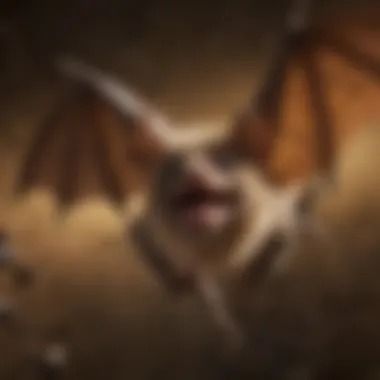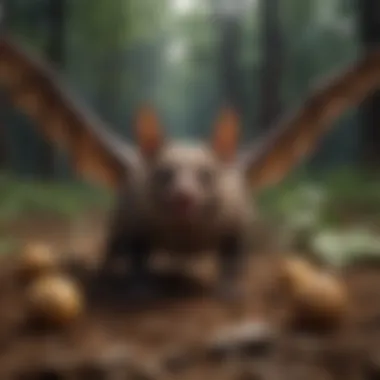Understanding Bats: Their Diets and Ecological Importance


Intro
Bats are remarkable creatures, often misunderstood yet playing crucial roles in various ecosystems. This article examines their diverse diets and how these dietary habits impact both the environment and agriculture. Understanding the types of bats, their food sources, and their ecological significance sheds light on their importance in maintaining biodiversity and controlling pests.
Animal Overview
Common Names
Bats belong to the order Chiroptera, which includes a wide array of species. Common names vary from little brown bat (Myotis lucifugus) to fruit bat (Pteropus species).
Scientific Classification
Bats are classified into two primary suborders, Microchiroptera and Megachiroptera. Microchiroptera, the smaller bats, are often insectivorous, while Megachiroptera, or flying foxes, primarily feed on fruit and nectar.
Geographic Range
Bats inhabit nearly every part of the world, except extreme deserts and polar regions. Their adaptability allows them to thrive in diverse habitats, including forests, caves, and urban areas.
Behavior and Social Structure
Social Behavior
Bats exhibit a range of social behaviors, from solitary living to large colonies. Many species, such as Myotis bats, roost in groups, which offers protection from predators and may enhance thermal regulation.
Communication
These animals utilize vocalizations and echolocation to navigate and locate food. Some species also engage in social calls to communicate with others in their roost.
Mating and Reproduction
Breeding behaviors vary across species. Some bats have unique mating rituals and may engage in seasonal migrations to breeding grounds. Gestation periods range, with most bats giving birth to one pup at a time.
Habitat and Ecosystem
Natural Habitat
Bats are highly adaptable and occupy a range of habitats. Forests, wetlands, grasslands, and urban areas support different species, each with specific needs for roosting and foraging.
Food Sources and Diet
Bats are excellent foragers, thanks to their diverse diets. They can be categorized based on what they eat:
- Insectivores: These bats primarily consume insects, aiding in pest control.
- Frugivores: Fruit-eating bats play a vital role in seed dispersal, impacting plant biodiversity.
- Nectarivores: Bats like the Leptonycteris species pollinate various plants, contributing to healthy ecosystems.
Role in Ecosystem
Bats provide essential services. They help control insect populations, which is beneficial for crops. Their role in pollination and seed dispersal further supports ecosystem health, demonstrating their ecological importance.
Bats contribute to pest control and pollination, making them invaluable in many ecosystems. Their decline would have serious consequences on agriculture and biodiversity.
In summary, understanding the diet and ecological roles of bats helps to emphasize their significance in wildlife conservation and the health of our environment.
Prelude to Bat Diets


The dietary habits of bats are fundamental to understanding not just the species themselves but also the broader ecosystems they inhabit. Bats are often overlooked in discussions about wildlife, yet their diverse diets provide essential services in many environments. This section aims to highlight the importance of bat diets, including how they impact ecological balance, agriculture, and biodiversity. Understanding these elements aids in grasping the role of bats in the food web, which is crucial for conservation efforts.
The Significance of Bats in Ecosystems
Bats play a crucial role in maintaining ecosystem health. They are natural pest controllers, consuming large quantities of insects each night. For instance, a single bat can eat thousands of moths and beetles, reducing the need for chemical pesticides in agriculture. This serves a dual purpose: protecting crops and ensuring that pest populations do not explode to harmful levels.
Moreover, bats are important pollinators. Some species specifically help in pollinating fruit trees and flowering plants. The agave plant, which is a primary source for tequila, relies on bats for effective pollination. Without bats, we might see a decline in these plants, impacting both natural ecosystems and economic activities tied to crop yields.
Impact on Biodiversity
Bats contribute to the richness of biodiversity within their habitats. By dispersing seeds from the fruits they consume, bats facilitate the growth of new plants, which in turn support various other species. This seed dispersal is essential for forest regeneration and for maintaining healthy habitats, especially in tropical regions where many bat species thrive.
Bats are among the most diverse groups of mammals, with over 1,400 species worldwide, showcasing their adaptability and ecological importance.
Bats as Diverse Consumers
Bats are not a homogeneous group when it comes to diet. Their feeding habits are varied, reflecting adaptations to their environments and available food resources. Their classification as insectivores, frugivores, nectarivores, carnivores, and sanguivores outlines their versatility as consumers.
- Insectivorous Bats: These make up the largest group, focusing primarily on insects. They have developed echolocation skills to catch prey in flight.
- Frugivorous Bats: These bats feed primarily on fruits, aiding in seed dispersion while consuming the fruit.
- Nectarivorous Bats: They look for flowering plants and are vital for pollination, similar to bees.
- Carnivorous Bats: This subset preys on small vertebrates, showcasing the predatory nature of certain bat species.
- Sanguivorous Bats: Known commonly as vampire bats, they have a very different diet, feeding on the blood of other animals.
Each of these dietary niches highlights how bats influence their ecosystems. The way bats consume and process food has lasting effects on plant life and insect populations, further emphasizing the importance of their dietary habits. Understanding these dynamics can help in wildlife conservation and in the promotion of sustainable agricultural practices.
Types of Bat Diets
The study of bat diets is central to understanding their role in the ecosystem. Bats consume a variety of foods, and this diversity reflects their adaptability and ecological niches. The types of diets are essential for pest control, pollination, and seed dispersal, showcasing their influence on biodiversity and agricultural practices. By classifying bats based on their dietary habits, we can better appreciate the complexity of ecosystems and the balance they maintain.
Insectivorous Bats
Insectivorous bats represent a significant section of bat species and play a crucial role in managing insect populations. These bats primarily feed on insects such as moths, beetles, and mosquitoes. Their feeding habits help reduce crop damage and can minimize the need for chemical pesticides.
Echolocation is a key mechanism used by insectivorous bats. They emit sound waves that bounce off objects, helping them detect prey in the dark. Many species have adapted to hunt specific insects, honing skills that increase their efficiency.
The ecological importance of insectivorous bats cannot be understated. A single bat can consume thousands of insects in one night, highlighting the impact they have on pest control and the overall health of ecosystems. Their presence often indicates a balanced environment, as they prey on various insects, preventing any single species from becoming too dominant.
Frugivorous Bats
Frugivorous bats play a vital role in seed dispersal and pollination, consuming fruit and in turn helping maintain plant diversity. These bats are primarily attracted to ripe fruits, which are a key source of energy and nutrients.
Through their feeding habits, frugivorous bats assist in the reproductive processes of numerous plant species. The seeds consumed are dispersed over large areas, often passing unharmed through the digestive system. This process fosters plant growth across different environments, contributing to ecosystem resilience.
Additionally, frugivorous bats have a significant influence on agriculture. They help to pollinate fruit trees, which can enhance crop yields. Their foraging behavior illustrates the intricate connections in nature, showing how one group can support the growth of another.
Nectarivorous Bats
Nectarivorous bats are specialized feeders that depend on the nectar of flowers. These bats typically have long snouts and specialized tongues, which enable them to reach deep into flowers. Their primary role is as pollinators, aiding in the reproduction of many plants, particularly in tropical and subtropical regions.
These bats are crucial for the fertilization of flowers, which directly supports fruit and seed production. As they feed, bats carry pollen from one flower to another, facilitating cross-pollination. Without their contributions, many plant species would face challenges in reproduction, leading to decreased biodiversity.
Moreover, nectarivorous bats have adapted to specific flowering patterns, often foraging at night while plants release their nectar. This nocturnal behavior reduces competition with diurnal pollinators, showcasing their unique ecological niche.
Carnivorous Bats
Some bat species are classified as carnivorous, feeding on small vertebrates such as fish and frogs. This group is less common but highlights the adaptability and varied diets of bats. Carnivorous bats have developed unique hunting strategies, employing both echolocation and visual cues while hunting.
Their role in the ecosystem includes natural population control of prey species. By preying on these small animals, they help maintain healthy ecological balances, preventing overpopulation and promoting biodiversity.


Studying carnivorous bats can provide insights into predator-prey dynamics and the overall health of their environments. This niche also illustrates the diversity within bat diets, showcasing the adaptability of these creatures.
Sanguivorous Bats
Sanguivorous bats, or vampire bats, are unique among their kin due to their blood-feeding habits. These bats typically feed on the blood of larger mammals, employing sharp teeth to make small incisions. This feeding behavior is complex, involving various adaptations that allow them to consume blood without harming the host significantly.
While sanguivorous bats may instill fear, they perform an essential role in their environments. Through their feeding activities, they can help reduce populations of some mammals, contributing to the balance of ecosystems.
These bats also demonstrate fascinating social behavior. They often share food with kin, revealing a level of social bonding and cooperation that is not common in many animal species. This characteristic provides insight into the complexities of bat social structures and their ecological interactions.
Feeding Mechanisms in Bats
Feeding mechanisms in bats are complex and highly adapted features that enable these mammals to thrive in a variety of ecological niches. Understanding how bats locate and capture their food is critical to appreciating their role in ecosystems. These mechanisms include specialized adaptations like echolocation and unique foraging strategies. Each of these elements is crucial for the survival and efficiency of bats in diverse environments.
Echolocation and Hunting
Echolocation is a key feature of many bat species, allowing them to navigate and hunt effectively in low-light conditions. By emitting high-frequency sound waves and listening for their echoes, bats can determine the location, size, and shape of objects in their surroundings. This ability is particularly important for insectivorous bats, which rely on echolocation to pinpoint flying insects while in flight.
The process of echolocation involves several steps:
- Sound Emission: Bats produce sound waves through their mouth or nostrils. The frequency of these sounds can vary depending on the species and the type of prey they are targeting.
- Echo Reception: The bats have highly specialized ears that can pick up the echoes of sound waves reflecting off objects.
- Signal Interpretation: Once the echoes return, the bat processes this information to calculate distances and assess the nature of the objects around them. This allows them to engage in precise hunting maneuvers.
The effectiveness of echolocation underscores its importance in the survival strategies of bats. It allows them to find food in complete darkness, significantly enhancing their foraging efficiency.
“Echolocation is one of nature's most impressive adaptations, enabling bats to fill ecological niches that others cannot.”
Foraging Strategies
Foraging strategies in bats vary widely based on dietary preferences and habitat. Different species employ distinct methods to maximize their foraging success. Some of these strategies include:
- Hawking: This method involves capturing prey in mid-air. Bats employing this strategy fly swiftly through the air, snatching insects with their mouths.
- Gleaning: Some bats prefer to forage from surfaces, capturing insects that rest on foliage or on the ground. This approach is often slower and requires careful maneuvering.
- Trap-lining: Certain bats establish and follow fixed routes where they find consistent food sources. This method allows them to optimize their foraging time effectively.
Bats also exhibit behavior known as group foraging. This can enhance hunting success when prey is abundant and is observed in some species, encouraging communal hunting strategies. Furthermore, habitat features like vegetation density and availability of roost sites greatly influence foraging behavior.
Impact of Bat Diets on the Environment
The diets of bats play a crucial role in the environment. This section will explore how the consumption habits of bats translate into significant benefits for ecosystems, agriculture, and biodiversity. Recognizing these impacts provides insight into the importance of these creatures in maintaining ecological balance.
Pest Control and Agriculture
Bats contribute immensely to pest control, especially in agricultural settings. As insectivorous bats consume vast quantities of insects, they directly reduce the population of pests that harm crops. A single bat can eat thousands of insects in one night, offering a natural alternative to chemical pesticides. This behavior not only promotes healthier crops, but also reduces farming costs associated with pest management.
The impact of bat predation on insects is particularly vital in regions where agricultural practices depend heavily on insect control. For example, vineyards and cornfields often face threats from pests like moths and beetles. The presence of bats helps to maintain pest populations at manageable levels, which ultimately supports sustainable agricultural practices.
"Bats serve as nature's pest control agents, proving that wildlife can play a key role in agriculture."
Using bats as a biological control method reduces the reliance on synthetic pesticides, which can have harmful side effects on the environment. Reduced pesticide usage means less chemical runoff into local waters, maintaining better water quality and protecting aquatic ecosystems.
Pollination and Seed Dispersal
Certain species of bats are important for pollination and seed dispersal. Frugivorous and nectarivorous bats are often essential for the reproduction of various plants. Many fruiting plants, such as bananas and guavas, rely on bats for their pollination. These bats fly from flower to flower, transferring pollen in the process. This behavior leads to increased fruit production and helps ensure plant diversity.
Furthermore, bats contribute to seed dispersal as they consume fruits and subsequently defecate the seeds in new locations. This act can lead to the growth of new plants in diverse ecosystems. In habitats such as tropical rainforests, bats are crucial for maintaining tree populations.


The interconnectedness between bats and plants supports overall ecosystem health. Healthy plant populations provide habitats for other wildlife and help stabilize ecosystems.
In summary, the dietary habits of bats exert significant influence over ecological systems. From pest control in agriculture to essential roles in pollination and seed dispersal, their impact cannot be underestimated. Understanding these pathways is essential for appreciating the inherent value of bats in our environments.
Common Misconceptions About Bats
Understanding the common misconceptions about bats is crucial for fostering a more informed view of these often-misunderstood creatures. Many people hold erroneous beliefs, which can lead to fear and unwarranted stigma. By addressing these misconceptions, this article aims to clarify misconceptions associated with bats, allowing for a deeper appreciation of their ecological roles and contributions to our environment.
Bats and Rabies
One of the most prevalent fears surrounding bats is that they are universally rabid and pose health risks to humans. While it is true that bats can carry rabies, the actual incidence of this disease in bats is relatively low. Studies suggest that only about 0.1%-0.5% of bats in a population might be infected. It is essential to understand that not todas bats have rabies.
In many cases, rabies transmission occurs only when a person is bitten by an infected bat. It is important to note that most bats are shy and avoid contact with humans. The risk to the general public remains low if bats are left undisturbed in their habitats. The Centers for Disease Control and Prevention provides guidance on how to avoid bites and the necessary actions if bitten, emphasizing the significance of not provoking these animals.
Understanding rabies in bats enables people to appreciate their role in controlling insect populations without fear.
Bats as Pests
Many people erroneously label bats as pests, claiming they invade homes and cause damage. This view overlooks the ecological role of bats and their contributions to pest regulation. Bats consume vast quantities of insects each night. A single bat can eat up to 1,200 mosquitoes in an hour, significantly reducing the pest population in agricultural and residential areas.
While some bats may occasionally roost in buildings, they generally seek shelter in caves, trees, or under bridges. Their presence in human structures is often not harmful; however, guano can accumulate and create hygiene concerns.
Addressing concerns about bats as pests involves educating the public about their benefits, such as the following:
- Natural Pest Control: Bats play an essential role in controlling insect populations that could otherwise harm crops.
- Biodiversity: By pollinating flowers and dispersing seeds, bats contribute to healthy ecosystems.
- Mutual Benefit: Encouraging bats to roost nearby can be a natural solution to pest problems for homeowners.
Conservation of Bats and Their Habitats
Bats play a critical role in many ecosystems, yet they are often misunderstood. Caring for bats and their habitats is vital not only for the species themselves but also for the overall health of the environments they inhabit. Conservation efforts can help maintain biodiversity, control pests, and promote pollination. Understanding the aspects of bat conservation informs the public, contributing to a more informed approach toward wildlife protection.
Threats to Bat Populations
Bats face numerous threats that have significantly impacted their populations across the globe. Some of the most pressing challenges include:
- Habitat Loss: Urbanization, deforestation, and agricultural expansion lead to the destruction of roosting and feeding sites. These actions reduce the availability of essential resources for bats.
- Pesticides: The widespread use of chemical pesticides not only decreases the availability of insects, a primary food source for many bat species, but also poses direct toxicity risks to bats.
- Climate Change: Shifts in temperature and precipitation patterns disrupt the natural cycles that bats depend on for breeding and feeding. Extreme weather can also result in roosts becoming uninhabitable.
- White-nose Syndrome: This fungal disease has devastated bat populations in North America, causing massive die-offs during hibernation.
Understanding these threats is crucial for devising effective conservation strategies that address the root causes of population decline.
Conservation Efforts and Their Importance
Conservation initiatives are necessary to mitigate the threats faced by bats and to ensure their survival. These efforts include:
- Habitat Restoration: Creating and protecting bat habitats can improve local ecosystems. Planting native flora helps increase insect populations that bats rely on for food.
- Legislation: Support for laws that protect bat habitats and regulate pesticide use can make a significant difference. Government actions at local, national, and international levels play an essential role in bat conservation.
- Research: Ongoing studies into bat populations, behaviors, and health are important for developing effective management strategies. Scientific research aids in understanding how best to protect these creatures.
- Public Awareness Campaigns: Educating the public about the importance of bats is key. Community outreach helps dispel misconceptions and encourages people to take action in protecting bats.
Effective conservation strategies not only benefit bats but also enhance the overall resilience of ecosystems.
In summary, engaging in active conservation of bats and their habitats leads to numerous ecological benefits, creating a healthier environment for all species. Without adequate attention to their needs, the loss of bats could have cascading negative effects on ecosystems and agriculture alike.
The End
Understanding the diets of bats is essential due to their significant roles in ecosystems. Bats serve as pest controllers, pollinators, and seed dispersers. Their varied diets not only help maintain the balance in their environments but also influence agricultural practices.
The Importance of Understanding Bat Diets
Understanding bat diets contributes to wildlife conservation. Bats fulfill vital ecological functions that often go unnoticed. For instance, insectivorous bats consume large quantities of insects, reducing the need for chemical pesticides. This not only helps farmers but also aids in maintaining biodiversity by regulating insect populations.
Frugivorous and nectarivorous bats are equally important. They assist in pollination and seed dispersal, facilitating plant reproduction and forest regeneration. The loss of bat species can lead to significant disruptions in these processes, affecting overall ecosystem health.
Additionally, recognizing misconceptions about bats enables better public understanding and support for conservation efforts. Many people fear bats due to outdated beliefs about disease transmission. Educating communities on the ecological benefits of bats can improve their conservation status.
In summary, a deeper understanding of bat diets emphasizes the complexity and interconnectedness of ecosystems. By appreciating these dietary habits, we can better advocate for the conservation of bat populations, which are crucial for a healthy planet. This knowledge is vital not only for bat enthusiasts but also for educators, students, and conservationists alike.







